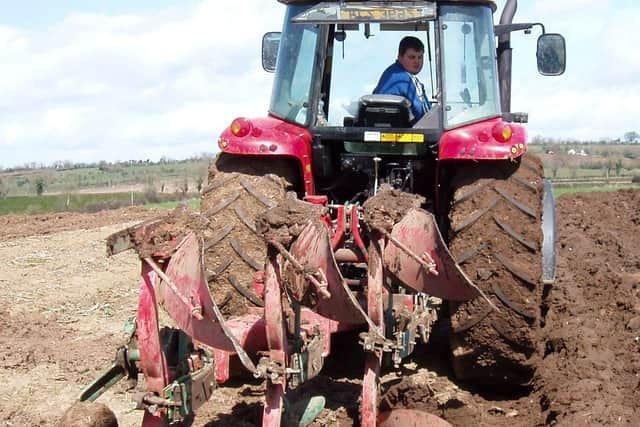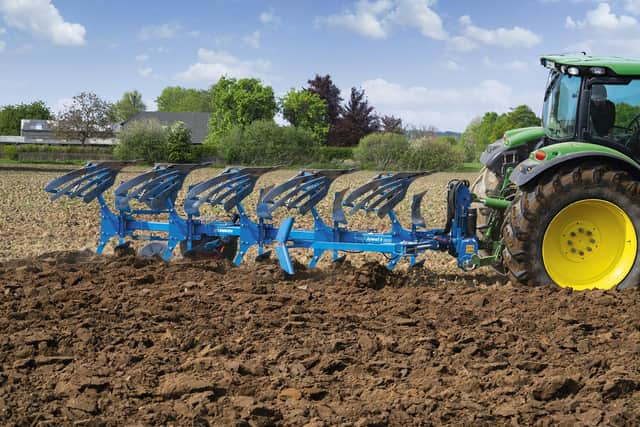‘Soils Day’ puts a clear focus on soil health
and live on Freeview channel 276
The event was held directly in the wake of the third global soil biodiversity conference, which had been jointly hosted by Teagasc and University College Dublin.
According to Teagasc’s Dr David Wall, managing soil health will be a critically important objective for farmers and all land users into the future.
Advertisement
Advertisement
He added that the care of our soils will have a fundamental impact on how we produce food and manage our environment.


Soil health
His colleague Dr Lilian O’ Sullivan discussed the various factors that come into play when determining the actual health of a soil.
She confirmed that soil health can be discerned in terms of a soil’s continuing capacity to function as a living eco system – one that is capable of sustaining plants, animal and humans.
O’Sullivan added:“It’s important that soils are healthy now and into the future.
Advertisement
Advertisement


“We want them to function as living ecosystems. Historically, our sole focus has been on the productive capacity of our land.
“In other words, the ability of our soils to produce food, fibre and raw materials like timber.
“And this will be important going forward. But as we look to the future, our soils will be expected to perform a number of other roles.”
O’Sullivan specifically highlighted the role of soils to re-cycle nutrients. She said that it is important to ensure that the nutrient recycling capacity of the soil is maximised.
Advertisement
Advertisement
If this is not being achieved, the end result will be the escape of green house gases to the atmosphere.
Clean water
According to O’Sullivan, healthy soils also play an important role in purifying our water. But, again, this comes back to the fundamental requirement of managing the recycling of nutrients within it effectively.
She continued:“We all need clean water. So it is important that our soils are managed in ways that makes this happen.
“Different soils have different water holding capacities. And this facet of a soil is important when it comes to determining its ability to successfully grow crops.
Advertisement
Advertisement
“Soil structure is particularly important. Soils also represent a habitat for so many plants and animals. They represent the engine room of biodiversity.
O’Sullivan went on to highlight the carbon sequestration and storage capacity of soils and the growing significance of these proven abilities, as mankind looks to the future.
It has been estimated that up to 70% of soils across Europe are unhealthy. In other words, one facet or another of their functionality has been compromised.
International legislation and government policy
This has generated a major call to action in terms of the legislative landscape and in terms of research and innovation. There is currently a major commitment at an international level to address the links between soil health and food.
Advertisement
Advertisement
According to O’Sullivan, the commitment to international research into soil health is now on a par with that dedicated to the challenge of cancer.
O’Sullivan commented: “We now have longer term goals in place, in terms of the European Green Deal. This includes the securing of climate neutrality.
“And the role of soil management techniques in helping to achieve this objective has already been recognised.
“We also have a new soil strategy. This means that by 2030, we are expected to have 70% of our soils in a healthy state. These are pan-European targets. In relative terms, Irish soils are comparatively healthy, compared to our European counterparts.
Advertisement
Advertisement
“However, it’s important to realise that soil health is very context orientated. Irish soils face a number of specific threats, which are different, for example, to those in the Mediterranean.
Actively managing our soils
O’ Sullivan pointed out that soil erosion is a major issue in southern Europe. Meanwhile, soil compaction is a key challenge in Ireland - brought on, for the most part, by the continuing use of heavy machinery.
Compaction can lead to increased surface run-off, flooding, erosion and transport of nutrients and agrochemicals to open water.
Compacted soils impede root development which can reduce yields. Along with reduced plant growth, poor aeration induces the loss of soil nitrogen and produces greenhouse gases through de-nitrification in anaerobic sites.
Advertisement
Advertisement
The Teagasc representative also highlighted salinisation and sealing as other factors that compromise soil functionality in Ireland.
She added: “Climate change will change the context within which we manage our soils. As a consequence, problems that we have not had to deal with in the past could arise in the future, unless we take the steps to stop them from arising in the first place.
“But there are also opportunities to be availed of in terms of soil management. Getting our organic manures balanced for fertility purposes. This is one of the biggest challenges faced by Irish agriculture. But this is an issue can be addressed.”
O’Sullivan pointed to the enhanced role for diversified grass swards into the future. Other mitigating factors that will maintain soil health include minimum tillage and cover crops.
Opportunities
Advertisement
Advertisement
Each soil, however, is different and must be managed accordingly. The starting point to all of this is actually measuring the health of a soil.
Courtesy of his presentation, David Wall explained that numerous opportunities will open up for farmers in response to them managing their soils more effectively.
But this will require evidence or a form of measurement, against which management/transition programmes can be developed.
“We will be measuring a number of soil health indicators,” said Wall
Advertisement
Advertisement
“Soil carbon indicators tell us about the organic matter levels within a soil. We also need to know if the carbon is simply locked away or is it active?
“In other words, is the organic matter in the soil actually feeding plants?
“Soil physical parameters are always important. And in this context, we know that soil compaction is an issue within Irish soils at the present time.
“Soil nutrient status is another priority. We have been looking at this specific issue for the past 50 years. However, today 50% of our soils are sub optimal in terms of pH, potash and phosphate.
Advertisement
Advertisement
“And this is before we get into the issue of soil micronutrients and other related issues.”
He continued:
“Water quality, and the link back to the nutrient status of many soils, is another indicator that we must take full account of.”
Wall highlighted the role of the various schemes that will be made available to allow farmers manage their soils that much better, adding that the betterment of soil quality on behalf of entire communities will represent additional income stream for farmers.
In this context, he referenced the agri environmental schemes within the new Common Agricultural Policy (CAP).
He commented:
Advertisement
Advertisement
“Carbon farming is an emerging opportunity for farmers and land managers to exploit the carbon sequestration and storage capacity of their soils.
“Improving soil health will also allow for the improved marketing of the food produced in Ireland.
“But it’s a case of being able to manage these parameters in the first place.”
Wall also highlighted the scope to expand Ireland’s organic farming sector into the future. Under the current national plan, the sector is to account for 7% of Ireland’s farmed area by 2030.
Advertisement
Advertisement
The Teagasc research scientist confirmed that Irish farmers would soon be in a position to draw down and trade ‘carbon credits’, based on the carbon sequestration and storage abilities of their soils.
But making this happen will require the accurate determination of a base line carbon inventory. This work is ongoing.
New fertiliser sources
Teagasc research scientists envisage a future, which will see a number of waste streams from industry and society at large actively ‘mined’ for their fertiliser content.
These include a range of food wastes and sewage sludge. Currently 60 technologies are being applied cross Europe, designed to maximise the fertiliser value of waste streams.
Advertisement
Advertisement
Here in Ireland, a focus has been placed on the use of sewage sludge as a soil conditioner and fertiliser source.
Incinerating the sludge leaves a residue that is an effective source of potash and phosphate. It is also pathogen-free.
However, sewage sludge is also an extremely important source of a very innovative source of mineral nitrogen and phosphate – Struvite.
The chemical complex also contains magnesium.
Struvite is fast being considered as an alternative source of rock phosphate within agricultural production systems.
Advertisement
Advertisement
And it will have a direct and beneficial impact on the Irish farming industry. A struvite manufacturing plant is currently under construction at Ringsend waste water treatment plant in Dublin. When fully operational the new plant will produce 14t of struvite per day.
Soil testing
The benefits to be accrued by Irish farmers in soil testing their lands on a regular basis were referenced by a number of the speakers at the Soils Day.
Moreover, the need to reflect the range of uses to which land is put within a soil testing regime was specifically highlighted.
For example, grazing paddocks that are cut for silage at different times of the year will have a different nutrient profile than those used exclusively for grazing.
Advertisement
Advertisement
On that basis, it is important that such locations are specifically sampled, from a soil testing point of view.
The benefits of applying lime on a regular basis, in order to keep soil pH values at optimal levels were also confirmed.
It will take greater quantities of lime per unit area to secure a specific pH lift within soils that have a high clay content.
But, conversely, these same soils will tend to have significantly higher pH buffering capacity relative to soils with a higher sand content.
Advertisement
Advertisement
Teagasc is confirming that up-to-date soil analysis will be required to apply fertiliser phosphorous in the years ahead.
Where soil samples are greater than four years-old, growers should plan to have fresh soil samples taken over the coming weeks, in order to plan and tailor crop fertiliser requirements.
Crop yields from harvest 2022 were above average for most crops. This will have resulted in increased offtakes of phosphorus (P) and potassium (K), so it is very important to now assess crop P and K offtakes and soil fertility over the coming weeks.
Teagasc analysed 3,794 tillage soil samples in 2021 and the results show a slight decline in soil fertility on tillage farms when compared to the previous year:
Advertisement
Advertisement
According to the latest figures, 18% of Irish soils have optimal pH, P and K values (a 6% year-on-year decrease); 61% of soils have a soil pH >6.5 (a 13% decrease); n57% of soils are at P index 1 and 2 (a 7% increase); and 32% of soils are at K index 1 and 2 (a 2% decrease).
Soil test results will provide recommended rates of lime to correct soil pH to the optimum pH 6.5 for a cereal crop rotation.
Where crops such as oilseeds, beans or beet are part of the crop rotation, a target soil pH of 6.8 is recommended.
Where possible, lime should be applied to correct soil pH levels based on the results of a recent soil test report.
Advertisement
Advertisement
Optimum soil pH improves soil function from better soil structure to improving nutrient recycling and availability.
Growers should use organic fertiliser where available to reduce fertiliser bills in 2023 and add organic matter to tillage soils.
These materials include cattle or pig slurry, poultry manures, composts or dairy sludge’s from the milk processing industry.